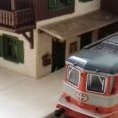Search the Community
Showing results for tags 'arduino'.
-
Hi, here is the layout I'm building. It has 2 independent layers, with two independent control panels (placed on the left and right hand side). The idea is that my two kids can play at the same time. Everything will be operated by an Arduino Mega board. Speed and direction of the trains will be controlled thanks to two LR293D IC connected to the Arduino. I will do the coding according to the control panel I've designed. The two control panels have switches for lights and other things like red light or the cable car, but right now I'll go through to the main part that operate the trains. From left to right (as shown on the picture), there is a FULL TOP switch – the equivalent of a hand-brake a HARD BRAKE button – to quickly decrease the speed a SOFT BRAKE button – to gently decrease the speed a HOLD switch – when turned on, the train maintains the current speed, if not it will slowly decelerate (unless the "increase speed" is being pushed). a INCREASE SPEED button – to accelerate a DIRECTION switch – to go forward or backward I've made a little "back door" underneath the layout. The Arduino board and the other boards are fixed to this door. All the cables are labelled and converge there. I try to make it as clean & clear as I can, for maintenance, future improvements and especially troubleshooting while coding the Arduino. Also, the little door is convenient since the layout is stored vertically (I don't have a lot of room, nor a man's cave 😔). Anyway, I can easily work on the electronics and cabling, while the layout is upright against the wall. That's it for now. I'll post more details through the next steps. I'll happy to reply if you have questions. I do have a question for the community tough. I've used Minitrix flexible track nailed directly on the 5mm plywood. I wonder if I should have put cork underneath the track. What's the purpose of it? reduce noise? easy track replacement? On the other hand, some of my turns are tight, and the nails+plywood hold everything in place very well. Bye for now
-
For a long time i've been thinking about collecting all the information i've found about layout automation using the arduino microcontroller. There have been some serious projects using this platform and imho it would be good if someone who is interested in the topic could find everything in one place. Many years ago, i've seen the tram controller article by Ken Shores, but don't know if the project was finished: http://sumidacrossing.org/MyOtherLayouts/SC/ElectricalSystems/TramController/ Since then, i've been doing some experimentation with both the Tomix TCS sensors and the Arduino. As a motor driver i've been using the L293D driver ic, but as i see the L298 is also popular for the same task. For automation, you'll need 3 basic things: -a way to control power to the motors (either analog or DCC) -a way to detect trains at various points or in various blocks -a way to change turnouts A nice optional feature is to have user controls, like analog throttles and input buttons. I plan to collect all the information and simple circuits i know about and maybe even get all the parts together for a complete system.









